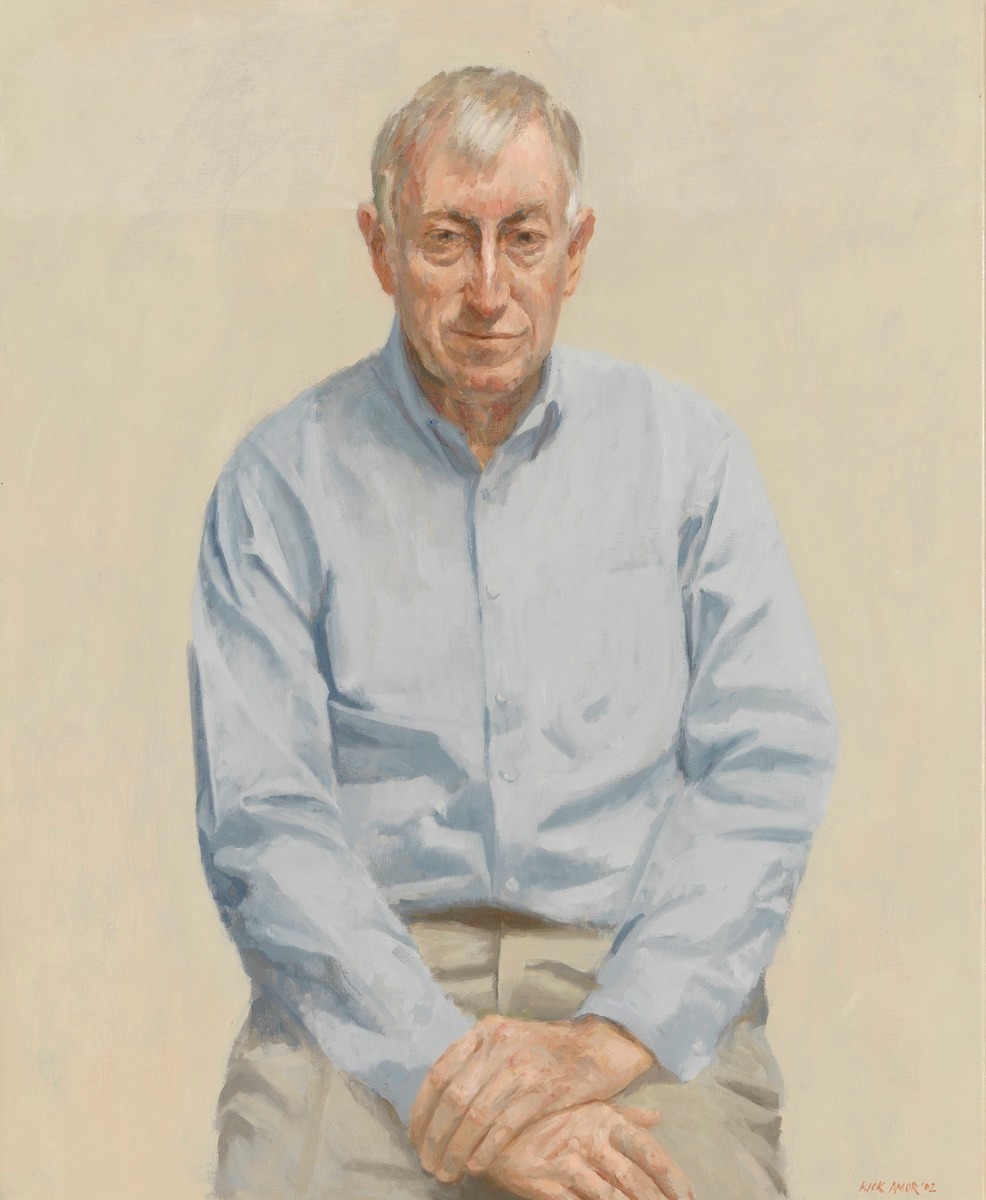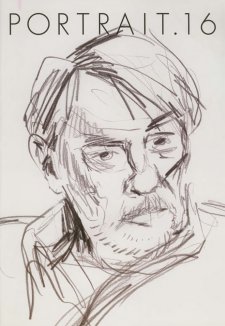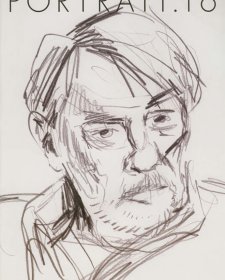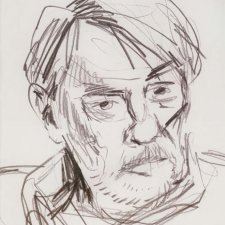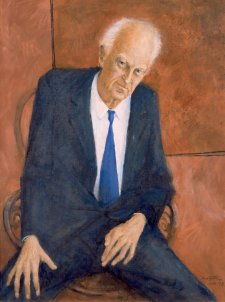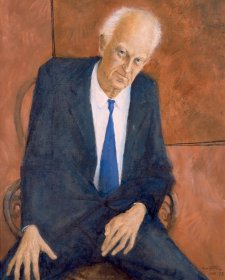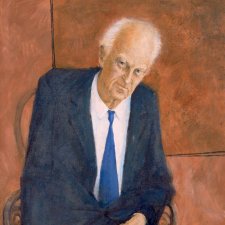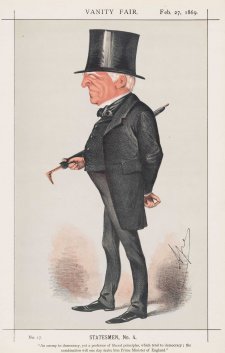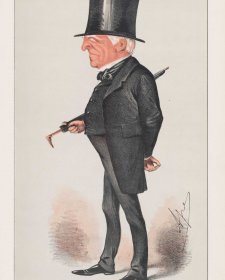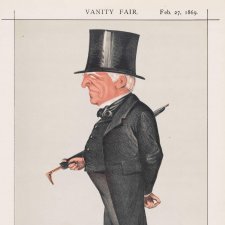Rick Amor (b. 1948), painter, printmaker and sculptor, spent his early childhood in the anomalous Melbourne beachside area of Long Island, near Frankston. He showed a strong talent for art in his early teens, and completed a Certificate of Art course before enrolling at Melbourne's National Gallery School.
Training under John Brack from 1966 to 1968 - the last years of the School's location in the heart of the city near the old Museum and State Library - he won the NGV Gallery Society Drawing Prize in 1967 and the Travelling Scholarship in 1968. He married, had his first child and worked briefly as a public servant before turning to painting full-time.
In the early 1970s, when he was represented by Melbourne dealer Joseph Brown, Amor and his family lived briefly at Clifton Pugh's artists' colony, 'Dunmoochin', at Cottles Bridge. Pugh had been a judge of the National Gallery Society Drawing Prize awarded to Amor, and he and Amor had met at the opening of Contemporary Australian Portraits, an exhibition mounted by Brown in September 1972 in which both artists were represented. After a short spell at 'Dunmoochin' the Amors moved into a cottage attached to Joan and Daryl Lindsay's home 'Mulberry Hill' on the Mornington Peninsula. Sir Daryl Lindsay, painter, arts administrator and art philanthropist, had been Director of the National Gallery of Victoria from 1941 to 1956; his wife Joan was also an artist, as well as the author of Picnic at Hanging Rock. Amor worked on his paintings in between carrying out odd jobs around the property for the elderly pair. His first solo exhibition was in early 1974. Portraits in that show, including a commissioned likeness of fledgling art dealer Charles Nodrum, attracted conflicting criticism. Although he conceded that 'no-one knows what to do about that commissioned portrait', Patrick McCaughey was dismayed by Amor's 'nightmarishly slick and commercial' style; Alan McCulloch, by contrast, judged him 'the only star so far to emerge from the era of John Brack's tutelage'. A year later Brown suggested that he seek another dealer, and finding himself without financial support, he began work as an illustrator.
Amor had participated in anti-war demonstrations as a young man, but his formal political involvement was spurred by Gough Whitlam's dismissal in November 1975 -just after the artist learned he had been awarded an Arts Council grant. He joined the Frankston branch of the ALP, and from 1975 to 1983, working as a cartoonist for the Labor Star and Tribune, he produced a spate of cartoons attacking the Fraser government. In 1976, with the dispensation of the formidable secretary of the Builders' Labourers' Federation, Norm Gallagher, he made a series of drawings of builders' labourers on a Melbourne shopping mall development. Over the next few years, in which he was supported by George Seelaf, the Victorian Trades Hall Council arts officer, he made successive portfolios of pictures depicting the construction of the West Gate Bridge and slaughtermen at work. The Miscellaneous Workers' Union commissioned him to make a mural for its Capel Streetheadquarters; in 1978 he held a large exhibition at the Trades Hall Display Centre; and in 1980 he was the artist-in-residence at the Victorian Trades Hall Council. To Amor, perhaps, his engaged art practice seemed a natural extension of his aesthetic commitment to realism, but it was out of step with prevailing ideas on the uneasy relationship between art and politics. As time passed, certain of his artist friends worried that his connections with the union movement and Labor left figures were impeding the natural progress of his work.
One of these friends was Andrew Southall (b. 1947), a self-taught painter in love with the spontaneous and disingenuous approach to painting that he perceived in the art of Arthur Boyd and John Perceval. After they met in 1981 Amor and Southall quickly became friends. In the ensuing years they often painted together on the Peninsula or at Baxter. Amor often depicted Southall in that period, and described his friend's customary approach to painting: 'he would concentrate intently as he juggled colour, composition and subject with a speed and assurance that was fascinating. The result was always a daring, memorable and creative interpretation of whatever was before him.' Amor has continued to paint en plein air, enjoying the various challenges of removing himself from the studio. Around 1993 he and Phil Davey, whom he had met through Southall, adopted an informal programme of painting outdoors every Friday morning. By 1996 the pair had been joined by several other painters, including Michael Kelly (b. 1956), a landscape artist and art teacher who held his first solo exhibitions in Melbourne in the early 1990s. Amor's former Sydney dealer, Tony Palmer, commented that Amor had made Kelly look 'Jacobean' in this portrait of 1998. Kelly's work was central to the exhibition Dunmoochin -A Tribute: Clifton Pugh and Michael Kelly, held in the former artists' colony of Montsalvat, near Eltham, in 2001. In 2003 the Friday Group marked its tenth anniversary with the exhibition 500 Fridays, which enjoyed a successful tour of Victoria.
In the mid-1980s, having settled into his ongoing association with Niagara Galleries, Amor left Mulberry Hill. He returned to Pugh's property at Cottles Bridge, moving into a house that had been occupied by John Olsen in 1969, the year Pugh painted him for the Archibald competition. Over some eight years there, tiring of the limitations and competing demands of committed art and becoming increasingly absorbed in the links between art, poetry and literature, Amor began to produce more personal and emotionally charged works, incorporating an anxiety-inducing 'running man', and later a haunting 'solitary watcher', the latter term coined by his friend, the art critic and poet Gary Catalano.
In 1978 Amor had become involved in the long-running Australian quarterly magazine Overland, aforum for challenging essays and dialogue on contemporary Australian politics and culture as well as poems, short stories and art. He was to serve on the board of Overlandfor some twenty years, and become a regular contributor - his portrait of Patrick White (1912-1990) was commissioned for the journal. Their common interest in the magazine and its concerns strengthened ties between Amor and Catalano (1947-2002), who had written on art for Art and Australia and the Melbourne Age. Catalano's first book of poetry appeared in 1978. Gradually abandoning criticism during the 1980s, he published four volumes of verse between 1991 and 1998. His prose poem 'Evening', first published in a 1992 issue of Overland, was dedicated to Amor and his second wife Meg Williams. Amor later made a number of works incorporating its motifs, including the painting Evening in Long Island, Victoria(1995-1997), as well as portraits of Catalano in various media. In the last decade of his life Catalano completed an absorbing biography of Amor, The Solitary Watcher: Rick Amor and his Art (2001) - from which much of the information in this article is drawn. Catalano died just days before he was announced as the recipient of a 2003 Harold White Fellowship to facilitate his research on a biography of poet David Campbell.
It was through his long friendship with Clifton Pugh, more than twenty years his senior, that Amor came to make several of the portraits recently acquired by the National Portrait Gallery, including the drawing of John Perceval reproduced on the cover of this issue of Portrait. John Perceval (19232000), painter and ceramic artist, was associated early on with the Angry Penguins, a group of rebellious, largely self-taught Australian artists including Sidney Nolan, Arthur Boyd and Albert Tucker. The group took its name from the Adelaide-based journal of the same name, edited by Max Harris. By the time the journal sank in the wash of the Ern Malley hoax in 1946, Perceval had moved on to Victoria, where he lived and worked as a potter and sculptor with the Boyd family at their property at Murrumbeena. He married the painter Mary Boyd, younger sister of Arthur; she would later marry Sidney Nolan. With Boyd, Pugh, Brack and others, Perceval signed the Antipodean Manifesto of 1959, decrying the 'bland and pretentious mysteries of abstract expressionism, geometric abstraction and related genres. In 1965 he took up the first Creative Arts Fellowship at the AustralianNational University, later awarded to both Nolan and Boyd. During this period Perceval was hospitalized for alcoholism; he spent the years from 1977 to 1986 in a psychiatric institution, fighting schizophrenia, but emerged to paint again in the last years of his life. Throughout these sad and difficult years Pugh would take Perceval, a friend since their days at the National Gallery School, out on day leave to draw and paint. Amor sometimes accompanied them. The cover drawing was one of several he made as Perceval was sitting to Pugh for the Archibald Prize of 1985. Amor worked up a number of his drawings of Perceval in different media; a woodcut based on one of them is now in the collection of the National Gallery of Australia, and the artist was recently interested to see a larger oil painting come up at auction.
The portrait of Perceval was not the only painting of Pugh's hung in the Archibald Prize of 1985-6; there was a second, of historian Manning Clark AC (1915-1991), the location of which is currently unknown. Clark lectured at the University of Melbournefrom 1944 to 1949, when he left to become Foundation Professor of History at CanberraUniversity College. This institution became the Australian National University, where Clark became the first Professor of Australian History in 1960. In the early 1970s, when his friend Arthur Boyd held the ANU Creative Fellowship, Boyd painted the historian with his black dog Tuppence in a work that is familiar to regular visitors to the Portrait Gallery. Some thirteen years later, as the historian was coming to the close of his controversial six-volume History of Australia (1962- 87), Amor, who knew Clark slightly through his wife's father, ANU academic Mick Williams, took the opportunity to draw him as Pugh was working on his portrait for the Archibald.
It was also during his domicile at 'Dunmoochin' during the 1 980s that Amor encountered the artist and entertainer Rolf Harris (b.1930), who had left Australia in 1952 to study art in England, and had begun his television career as a cartoonist-storyteller in London the following year. Amor met the multifariously talented Harris when he stayed for a week with Pugh, an old mate. One day when Pugh took the car out, leaving Harris with an empty fridge, Harris, who was in the process of drawing illustrations for his novella Win or Die: The Making of a King, wandered down to the Amors' house looking for company and something to eat. In Amor he found the perfect model for the ungovernable gypsy giant central to his story, and several readily recognisable renditions of the artist with 'teeth bared in a ghastly grin' can be seen in the book. In turn, Amor drew Harris as he found him offstage - the 'archetypal melancholy clown'.
In the late 1980s Amor began making sculptures, an example of which is the disturbing bronze of a dog that stands outside the National Gallery of Australia. Over the course of the next few years he was awarded several art residencies and worked in Barcelona, New York and London. He has become a highly regarded portrait painter and a regular exhibitor in the Archibald Prize, in which he first exhibited a portrait of Joan Lindsay in 1976. Sitters in portraits subsequently hung in the Prize include barrister and republican activist Malcolm Turnbull (1987); writer and ABC managing director Brian Johns (1988); friend and fellow artist Paul Boston (1996); author Peter Carey (1997), preparatory sketches of whom Amor made while occupying the Visual Arts/Crafts Board Green Street Studio in New York; Gallery Director Bruce Pollard (1998); artist Lewis Miller (2003); and crime writer Shane Maloney (2005). He has made many strong self-portraits, aiming to include one in each of his annual shows; one of them hung in the Archibald exhibition of 1999. That year, appointed Australia's first official war artist since Vietnam, Amor travelled to East Timor to document the devastated land and the reconstruction efforts of peacekeepers. His appointment, attributable both to his high reputation and his long experience as a plein air painter, attracted much media attention, making the front page of the Age. The works that he made, both in sketchbooks in Timor and in gouache and oils upon his return, are in the collection of the Australian War Memorial.
Amor continues to exhibit regularly in Melbourne, the city of which several of his paintings have become defining images. Most major Australian galleries own examples of his work.
